White kitchen cabinets have long been a favorite among homeowners and designers alike—and for good reason. They bring a sense of brightness, cleanliness, and timelessness to any kitchen space. Whether you're designing a sleek modern kitchen or a cozy farmhouse-style heart-of-the-home, white cabinets provide the perfect neutral backdrop.
But when it comes to completing your kitchen design, one of the most impactful choices you’ll make is your countertop material and color. The right countertop can elevate your white cabinetry from simple to stunning, while the wrong choice might leave your space feeling flat or mismatched.
This comprehensive guide is designed to help you navigate the many options available when choosing countertops that beautifully complement your white cabinets. From popular materials like quartz and marble to budget-friendly alternatives like laminate, we’ll explore what works best, why it works, and how to choose based on your lifestyle, aesthetic preferences, and practical needs.
By the end of this guide, you’ll feel confident in making an informed decision that not only enhances the beauty of your kitchen but also stands the test of time—both in style and durability.
Before jumping into specific materials or colors, it helps to understand the basics of white cabinets and what makes them such a versatile choice in kitchen design.
White cabinets are beloved for their clean, classic look and their ability to make even small kitchens feel more open and airy. They’re also incredibly flexible—you can pair them with nearly any color or texture of countertop to achieve the exact mood you’re going for.
That said, not all white cabinets are created equal. There are warm whites (with undertones of yellow, beige, or ivory), cool whites (with hints of blue or gray), and stark whites (bright, almost clinical tones). Each of these will influence how different countertop colors and materials appear next to them.
When selecting a countertop to go with your white cabinets, there are several key factors to keep in mind:
Style: Are you aiming for a minimalist modern kitchen, a rustic farmhouse vibe, or something more traditional? Your overall design direction will help narrow down your options.
Durability: How much wear and tear will your countertop endure? If you cook often or have kids, you may want a material that’s scratch-resistant and easy to clean.
Maintenance Level: Some materials require regular sealing or special cleaning products, while others are virtually maintenance-free.
Budget: Countertop prices vary widely—from affordable laminate to high-end natural stone. Decide what you’re willing to invest before diving into specifics.
Color Harmony: As mentioned earlier, the undertone of your white cabinets plays a big role in which countertop colors will work best. Matching or contrasting these tones thoughtfully can create a cohesive and visually appealing kitchen.
Understanding these foundational elements will help you make more intentional and satisfying choices as we explore each countertop material in detail.
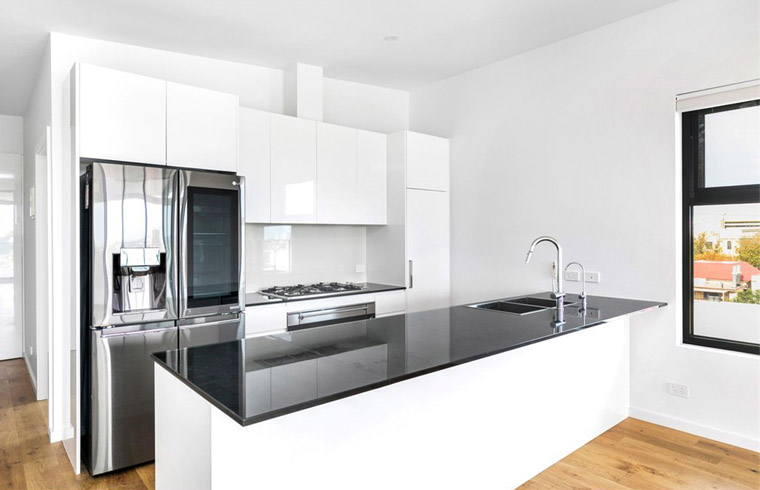
When it comes to designing a kitchen with white cabinets, choosing the right countertop material is one of the most impactful decisions you’ll make. Each material brings its own unique combination of style, durability, maintenance needs, and cost. Whether you're looking for timeless elegance, modern minimalism, or budget-friendly practicality, there’s a countertop material that will perfectly complement your white kitchen cabinetry.
Let’s explore the most popular options—quartz, marble, granite, wood, concrete, laminate, and even soapstone—so you can decide which one best suits your space and lifestyle.
Quartz countertops have become one of the top choices for homeowners in recent years—and for good reason. Made from ground natural quartz combined with resins and pigments, these surfaces are non-porous, highly durable, and available in a wide range of colors and patterns.
Pros:
Non-porous surface – Resists stains and bacteria without needing regular sealing.
Consistent color and pattern – Unlike natural stone, quartz offers uniformity across slabs.
Low maintenance – Wipe clean with mild soap and water; no need for sealing.
Scratch-resistant – Holds up well under daily use.
Cons:
Heat sensitivity – Avoid placing hot pots directly on the surface.
Higher cost – Typically more expensive than laminate or tile.
Not 100% natural – Some people prefer the authenticity of natural stone.
Best Colors for White Cabinets:
Pure White: For a sleek, monochromatic look.
Light Gray or Silver Veins: Adds subtle contrast while keeping the space bright.
Marble-Like Patterns: Offers the beauty of marble without the upkeep.
Warm Beige or Taupe: Softens the overall look and adds warmth.
Quartz works especially well in modern, minimalist, and contemporary kitchens, where clean lines and low-maintenance surfaces are key. It also pairs beautifully with cool-toned white cabinets, creating a crisp, polished aesthetic.
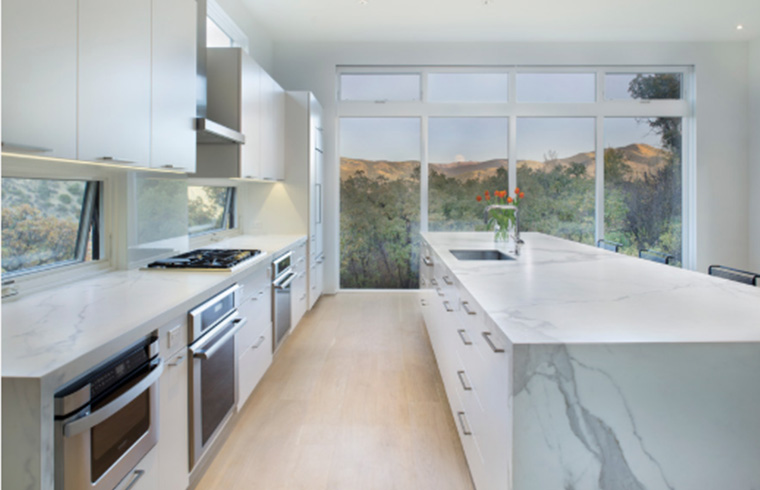
Marble has been a symbol of luxury in kitchens and bathrooms for centuries. Known for its soft veining and cool tones, marble brings an air of sophistication to any space. While traditionally used in bathrooms, it's becoming increasingly popular in high-end kitchens as well.
Pros:
Luxurious appearance – No other material rivals marble’s elegance.
Unique veining – Each slab is one-of-a-kind.
Cool surface – Ideal for rolling out dough or tempering chocolate.
Cons:
Porous surface – Requires regular sealing to prevent staining.
Acid-sensitive – Can etch when exposed to lemon juice, vinegar, or wine.
Softer than quartz or granite – More prone to scratches and chips.
Best Colors for White Cabinets:
White Carrara: Classic choice with soft gray veining.
Calacatta Gold: Dramatic veining with gold undertones.
Emperador Dark: Rich brown tones for a bold contrast.
Marble pairs exceptionally well with warm white cabinets, enhancing the creamy or ivory undertones. It’s perfect for traditional, classic, or transitional kitchens, though it does require more care than some other materials.
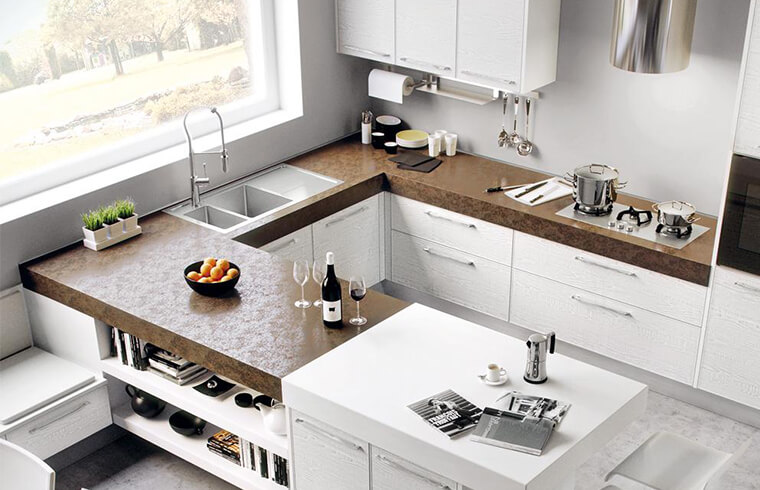
Granite is one of the most durable natural stones available and has long been a favorite for kitchen countertops. Formed from cooled magma, each slab features a unique blend of minerals, making every countertop distinct.
Pros:
Extremely durable – Resists heat, scratches, and wear.
Natural beauty – Each slab has a one-of-a-kind look.
High resale value – Adds appeal to potential home buyers.
Cons:
Requires sealing – Every 1–2 years to prevent staining.
Heavy weight – May require additional support during installation.
Costly – Especially for rare or exotic colors.
Best Colors for White Cabinets:
Black Absolute: Bold contrast that makes white cabinets pop.
White Ice: Light-colored granite with subtle veining.
Santa Cecilia: Warm golden tones for a cozy feel.
Blue Bahia: Striking blue-gray for a statement-making design.
Granite is ideal for those who love the idea of natural stone but want something more resilient than marble. It complements both cool and warm white cabinets, depending on the color variation chosen. It works especially well in traditional, rustic, and transitional kitchens.
Wood countertops bring a sense of warmth and organic texture into the kitchen. Often made from maple, walnut, or oak, they’re a great option for farmhouse-style or Scandinavian-inspired kitchens.
Pros:
Natural warmth – Adds coziness to the space.
Can be sanded and refinished – Lasts for decades with proper care.
Soft surface – Gentle on knives and easy to cut on directly.
Cons:
Requires regular oiling – To prevent drying and cracking.
Susceptible to moisture – Needs sealing to avoid warping or bacterial growth.
Less heat-resistant – Not ideal for placing hot pans directly on the surface.
Best Wood Types for White Cabinets:
Maple: Light and smooth, blends seamlessly with white.
Walnut: Rich dark tone creates a beautiful contrast.
Cherry: Medium brown with warm undertones.
Wood countertops pair beautifully with white shaker cabinets or farmhouse-style designs, offering a natural, handcrafted feel. They work best in rustic, cottage, or Scandinavian-themed kitchens, where texture and warmth are key elements.
Concrete countertops offer a bold, industrial-chic look that’s gaining popularity among modern homeowners. Unlike traditional materials, concrete can be custom-cast to fit your exact kitchen layout, giving you full control over shape, thickness, and finish.
Pros:
Customizable – Can be molded into any shape or size.
Durable when sealed – Resists heat and impact.
Modern aesthetic – Perfect for urban or minimalist spaces.
Cons:
Prone to cracking – Without proper reinforcement.
Heavy weight – May require structural support.
Sealing required – Must be sealed regularly to prevent staining.
Best Colors for White Cabinets:
Gray Tones: From light ash to deep charcoal.
White-washed Finish: Gives a softer, textured look.
Colored Concrete: Add pigment for a personalized touch.
Concrete is ideal for those who want a highly customized, artistic countertop that stands out. It pairs well with cool-toned white cabinets, especially in industrial, loft-style, or modern kitchens.
Laminate countertops remain a popular choice due to their affordability and wide range of styles. Today’s laminates have come a long way from the outdated looks of the past, offering realistic wood grain, stone-like finishes, and even metallic effects.
Pros:
Affordable – One of the most cost-effective options.
Easy to install – DIY-friendly and quick to replace.
Wide variety of designs – Mimics wood, stone, concrete, and more.
Cons:
Less durable – Can chip or scratch more easily than stone or quartz.
Shorter lifespan – Typically lasts 10–20 years before needing replacement.
Not heat-resistant – Avoid placing hot items directly on the surface.
Best Styles for White Cabinets:
Solid White or Off-White: For a seamless, all-white look.
Concrete Look: Adds modern flair at a fraction of the cost.
Wood Grain: Brings warmth and texture to a bright kitchen.
Speckled or Flecked Patterns: Imitates natural stone with added depth.
Laminate is a smart choice for rental properties, starter homes, or anyone working with a tight budget. It’s especially effective in contemporary or minimalist kitchens, where clean lines and simplicity take center stage.
Soapstone is a lesser-known but highly desirable natural stone countertop material. Known for its smooth, matte finish and rich dark tones, soapstone develops a patina over time, adding character and uniqueness to your kitchen.
Pros:
Naturally resistant to stains and bacteria – Non-porous surface.
Heat-resistant – Safe for placing hot pots directly on the surface.
Develops a beautiful patina – Gains charm with age.
Cons:
Soft surface – Prone to scratches (can be sanded out).
Dark color palette – Limited to shades of black, gray, and green.
Requires oiling – To enhance color and protect the surface.
Best Colors for White Cabinets:
Classic Black: Creates a dramatic, elegant contrast.
Charcoal Gray: Softer alternative with a modern edge.
Greenish-Toned Soapstone: Adds visual interest and depth.
Soapstone is a fantastic option for those who want a unique, low-maintenance natural stone that ages gracefully. It pairs especially well with white upper cabinets, creating a strong visual contrast. Ideal for modern, minimalist, or luxury kitchens.
Material | Durability | Maintenance | Style | Cost | Best For |
Quartz | High | Low | Modern, Minimalist | $$$ | Busy kitchens, low maintenance |
Marble | Medium | High | Elegant, Classic | $$$$ | Design-focused, formal kitchens |
Granite | Very High | Medium | Traditional, Rustic | $$$ | Homeowners seeking natural beauty |
Wood | Medium | Medium | Farmhouse, Scandinavian | $$ | Cozy, textured kitchens |
Concrete | High | Medium | Industrial, Modern | $$$ | Custom, artistic spaces |
Laminate | Low | Low | Contemporary, Budget-friendly | $ | Rentals, starter homes |
Soapstone | Medium | Medium | Luxury, Modern | $$$ | Those who appreciate patina |
Choosing the right countertop material for your white cabinets ultimately depends on your lifestyle, design preferences, and budget. Whether you lean toward the sleekness of quartz, the elegance of marble, the warmth of wood, or the affordability of laminate, there’s a countertop solution that will bring your vision to life.
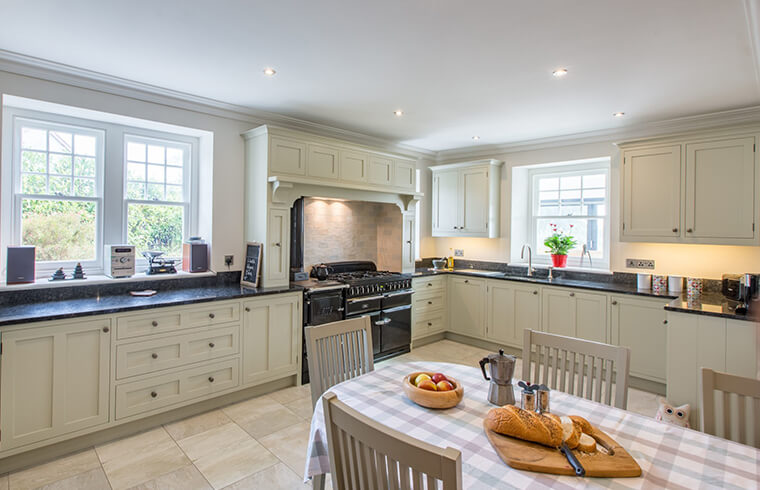
Before diving into specific color combinations, it’s important to understand the concept of undertones in white cabinets. Whites can have either warm (yellow, beige, cream) or cool (blue, gray, green) undertones, which significantly affect how different countertop colors appear when paired together.
For warm-toned white cabinets, consider countertops that enhance their golden or creamy hues. Materials like wood, soapstone, and even some granite options with warmer beige flecks work well here.
Wood Countertops: A rich walnut or cherry wood countertop adds warmth and texture, creating a welcoming farmhouse or rustic vibe.
Soapstone: With its natural dark tones and ability to develop a beautiful patina over time, soapstone brings depth and character to a kitchen with warm white cabinets.
Granite: Look for slabs with warm beige or brown veining to complement the creamy undertones of your cabinets.
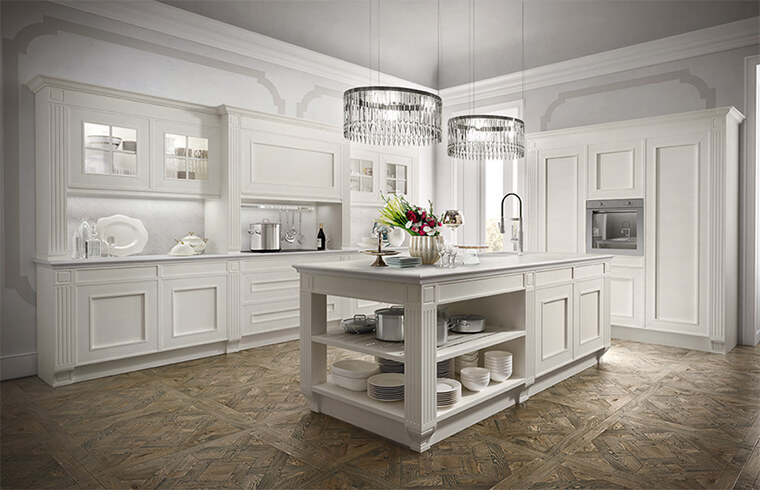
Cool-toned white cabinets benefit from countertops that reinforce their fresh, crisp look. Opt for materials like quartz, marble, or concrete to achieve a sleek, modern appearance.
Quartz: Choose slabs with gray or silver veins to maintain a consistent cool tone throughout the kitchen. Pure white quartz also works beautifully for a minimalist look.
Marble: Carrara marble, with its soft gray veining, adds elegance without overwhelming the space. For a bolder statement, Calacatta Gold offers striking veining against a cooler white background.
Concrete: Its raw, industrial appeal pairs wonderfully with cool white cabinets, especially in contemporary or loft-style kitchens.
True white cabinets offer the most flexibility when choosing countertop colors. However, be cautious not to choose something too plain or overly contrasting, as this could make the space feel cold or uninviting.
Quartz: Select a shade slightly lighter or darker than your cabinets to add dimension without overpowering the room.
Granite: Consider slabs with subtle speckles or flecks in neutral tones for added interest without detracting from the purity of the white cabinets.
Laminate: High-quality laminate mimicking natural stone or concrete can provide a cost-effective solution while maintaining a sophisticated look.
Deciding whether to go for a high-contrast or harmonious look depends largely on personal preference and the overall style of your kitchen.
High Contrast: If you want your countertops to stand out and become a focal point, opt for bold colors like black granite, dark soapstone, or deep wood tones. This approach works particularly well in larger kitchens where the contrast adds drama without feeling cramped.
Harmony: For a more cohesive look, select countertop colors that subtly blend with your cabinets. Light gray quartz, pale wood, or white marble with minimal veining can create a serene, unified appearance.
Let’s take a closer look at how different countertop choices impact the perception of space and mood:
l Small Kitchens: In smaller kitchens, light-colored countertops paired with white cabinets help create an illusion of spaciousness. Consider using reflective surfaces like polished quartz or glossy laminate to further enhance this effect.
l Large Kitchens: Larger spaces afford more freedom in terms of countertop selection. Darker countertops can add warmth and intimacy, preventing the room from feeling too vast or impersonal.
Blues and Greens: Often associated with calmness and tranquility, these shades can be incorporated into countertops through materials like soapstone or engineered quartz with subtle blue-green veining.
Greys and Silvers: Known for their sophistication and neutrality, these tones are excellent for achieving a modern, minimalist aesthetic.
Finally, don’t overlook the role of lighting in determining how countertop colors appear next to your white cabinets. Natural light versus artificial lighting can dramatically alter the perceived hue of both your cabinets and countertops.
Natural Light: In kitchens flooded with natural daylight, cooler tones may appear brighter and more vibrant, while warmer tones might seem softer.
Artificial Lighting: Under artificial lights, especially those with a yellowish tint, cooler tones can sometimes read as dull or washed out. Conversely, warmer tones may appear richer and more saturated.
Testing samples under various lighting conditions before making a final decision ensures you’re happy with the outcome once installed.
By carefully considering the undertones of your white cabinets, desired level of contrast, and the emotional impact of color, you can confidently select a countertop material and color that not only complements your cabinetry but also elevates the entire kitchen design.
While choosing the right countertop material and color for your white cabinets is a major design decision, it’s just one piece of the puzzle. To truly elevate your kitchen and create a cohesive, well-thought-out space, you’ll want to pay attention to other key design elements that work together with your countertops and cabinetry.
In this section, we’ll explore how to enhance your kitchen by carefully selecting and coordinating:
Backsplashes
Hardware (knobs, pulls, and handles)
Flooring
Lighting
Wall paint or finishes
Island or accent surfaces
Each of these details plays a role in shaping the overall aesthetic and functionality of your kitchen. Let’s dive in!
A backsplash serves both a practical and decorative purpose—it protects your walls from splatters while also acting as a visual connector between your countertops and cabinets.
Matching vs. Contrasting:
Matching: A backsplash in the same color family as your countertop can create a smooth transition and make the space feel more unified.
Contrasting: If your countertop is bold or dark, consider a lighter backsplash to break up the heaviness and add visual interest.
Popular Backsplash Materials:
Ceramic or Porcelain Tile: Affordable, durable, and available in countless colors and patterns.
Subway Tiles: A classic choice that pairs beautifully with white cabinets—especially when used with colored grout for contrast.
Natural Stone (Marble, Travertine): Adds luxury and complements natural stone countertops like marble or granite.
Glass Tiles: Reflective and modern, great for small kitchens where light needs to bounce around.
Metallic or Mosaic Tiles: For those who want to make a statement.
Pro Tip:
If you have a white quartz countertop with gray veining, try a light gray glass tile backsplash to echo the pattern and maintain harmony. Or, if you're going for contrast, opt for a deep navy or black subway tile to frame the space dramatically.
Kitchen hardware may be small, but it has a surprisingly large impact on the overall style. Since white cabinets are neutral, the hardware becomes one of the few visible elements that can inject personality into the space.
Style Considerations:
Modern/Minimalist: Sleek bar pulls or recessed finger pulls in brushed nickel, matte black, or chrome.
Farmhouse/Country: Oil-rubbed bronze or antique brass bin pulls and cup-style drawer pulls.
Traditional: Classic brass or polished chrome knobs.
Industrial: Matte black or steel linear handles.
Color Coordination:
Match your hardware finish to other metallic elements in the kitchen—like faucets, lighting fixtures, or appliances.
If you have stainless steel appliances, go for brushed nickel or chrome hardware.
If your countertops or backsplash include warm wood tones, consider brass or copper finishes for a cohesive look.
Size Matters:
Larger drawers benefit from longer pulls, while smaller cabinets can handle shorter ones.
Don’t underestimate the importance of ergonomics—handles should be easy to grip and not protrude too far.
Your flooring sets the stage for everything else in the kitchen, so it’s important to choose wisely based on durability, style, and color coordination.
Material Options:
Hardwood: Warm and timeless, especially when paired with wood countertops or warm-toned cabinets.
Tile (Porcelain or Ceramic): Durable, water-resistant, and perfect for high-traffic areas.
Vinyl/LVT (Luxury Vinyl Tile): Budget-friendly, comfortable underfoot, and increasingly stylish.
Concrete: Industrial-chic and ideal for modern or minimalist spaces.
Natural Stone (Marble, Limestone): Luxurious but requires regular maintenance.
Color Pairing Tips:
White cabinets + light countertops = Go for darker floors (charcoal, walnut) to anchor the space.
White cabinets + dark countertops = Light wood or pale stone floors help balance the contrast.
Patterned floors (like hex tiles or encaustic cement) add visual interest but work best in larger kitchens to avoid feeling busy.
Maintenance Reminder:
Choose flooring that can stand up to daily wear and tear. In homes with kids or pets, waterproof vinyl or durable porcelain tile might be the most practical choices—even if they aren’t the most luxurious.
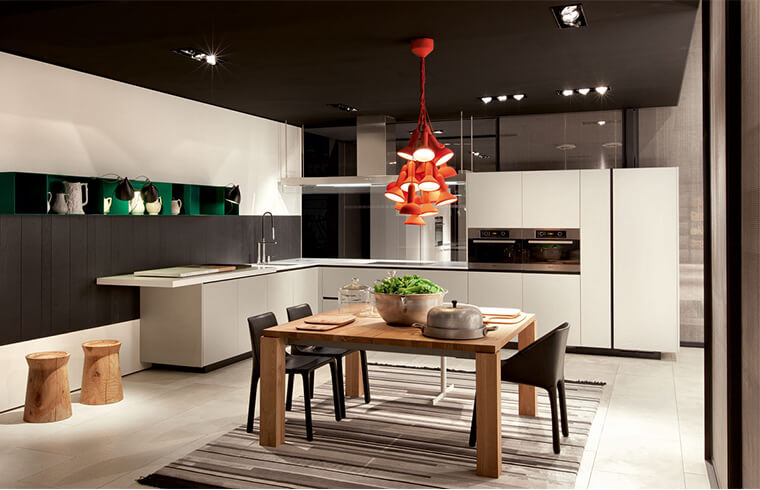
Lighting is often overlooked in kitchen design, but it has a powerful effect on how your countertops and cabinets appear throughout the day.
Natural Light:
Kitchens with plenty of windows tend to show off countertop colors accurately.
Be mindful of how different materials look at various times of the day—some stones can appear cooler or warmer depending on the sunlight.
Artificial Lighting:
Under-cabinet lighting: Highlights your countertops and adds warmth to the workspace.
Pendant lights over the island: Great for task lighting and style, especially when using unique shapes or metallic finishes.
Recessed ceiling lights: Provide even illumination without drawing attention to themselves.
Finish Coordination:
Match your light fixture finishes to your hardware and faucet for a unified look.
If your countertops have cool undertones, go for white or silver lighting. For warmer tones, brass or gold fixtures add richness.
Even though your cabinets are white, the wall color still plays a subtle but significant role in setting the tone of the room.
Recommended Colors:
Soft Greys or Blues: Cool tones that complement white cabinets and modern countertops.
Warm Whites or Creams: Create a softer, more inviting atmosphere.
Bold Accents (Charcoal, Forest Green, Navy): Use sparingly on one wall to create drama without overwhelming the space.
Texture Ideas:
Shiplap or beadboard: Adds texture and charm, especially in farmhouse or coastal-style kitchens.
Painted brick or concrete walls: Industrial flair that pairs well with concrete countertops and stainless steel appliances.
If your kitchen includes an island, don’t miss the opportunity to use it as a design highlight. You can either match the main countertop or go for something completely different to draw the eye.
Option 1: Same Material
Creates a seamless, unified look—ideal for minimalist or contemporary designs.
Especially effective when using bold-colored countertops, such as black soapstone or deep green granite.
Option 2: Contrasting Material
Try a butcher block top on the island for warmth and contrast with white quartz or marble countertops.
Or go for a bold color, like terracotta or emerald green laminate, to make the island a standout feature.
Extra Tip:
You can also play with different edge profiles or finishes on the island countertop to differentiate it slightly from the main area.
Here are some daily maintenance tips for white cabinets to help you maintain their fresh and bright look for a long time.
Daily Cleaning Routine:
Use Soft Cloths: Always use soft, non-abrasive cloths or sponges to wipe down your cabinets. Avoid using rough materials that could scratch the surface.
Mild Soap Solution: Mix a small amount of mild dish soap with warm water for daily cleaning. This is gentle enough not to damage the finish.
Dry Immediately: After cleaning, make sure to dry the cabinets thoroughly to prevent water spots or moisture damage.
Removing Stubborn Stains:
Baking Soda Paste: For tough stains, mix baking soda with a little water to form a paste. Gently apply this paste to the stain, let it sit for a few minutes, then wipe clean with a damp cloth.
Avoid Harsh Chemicals: Stay away from bleach or other strong chemicals, as they can discolor or damage the cabinet finish.
Maintaining Shine:
Regular Buffing: Periodically buff your white cabinets with a microfiber cloth to maintain their shine and remove any fingerprints or smudges.
Furniture Polish: For painted or lacquered white cabinets, you can occasionally use a small amount of furniture polish to enhance the luster. Be sure to test on an inconspicuous area first.
Hardware Maintenance:
Tighten Hinges and Handles: Regularly check and tighten any loose hinges or handles to ensure smooth operation and prevent wear.
Clean Metal Fixtures: Use a soft cloth dipped in soapy water to clean metal handles and pulls, then dry immediately to avoid rusting.
As we conclude this comprehensive guide on designing a kitchen with white cabinets, let us summarize the key insights and design principles that will help you create a space that is not only beautiful but also functional and timeless.
When designing your ideal kitchen, it's important to balance aesthetics with practicality. Here are several guiding principles:
Balance Aesthetics and Practicality Choose materials and finishes that can withstand daily use without sacrificing style.
Think in Layers A well-designed kitchen integrates various elements such as countertops, cabinetry, backsplashes, hardware, lighting, and flooring into a cohesive whole.
Play with Contrast White cabinets offer a blank canvas for introducing contrast through dark countertops or bold flooring. Use these elements wisely to add depth and character.
Choose Timeless Over Trendy Opt for classic combinations that stand the test of time. Save trendy elements for accessories or fixtures that can be easily updated.
Invest Where It Matters Most Prioritize spending on high-impact areas like countertops and cabinetry, which are both highly visible and frequently used.
Here’s a quick summary of essential tips from this guide:
Countertop Materials: Consider quartz, granite, marble for durability; wood and concrete for warmth; laminate for budget-conscious options.
Color Pairing: Light countertops keep spaces airy while darker ones add sophistication. Neutral tones provide versatility, whereas bold colors make statements.
Backsplash Selection: Match or contrast thoughtfully. Subway tiles, glass mosaics, and natural stone are excellent choices.
Hardware Style: Select hardware that reflects the overall kitchen style. Coordinate finishes with other metallic elements.
Flooring Choice: Balance light and dark tones, prioritizing durability and ease of cleaning. Hardwood, tile, and luxury vinyl are recommended.
Lighting Strategy: Layer ambient, task, and accent lighting. Coordinate fixture finishes with other metals in the kitchen.
Wall Color: Soft grays, warm whites, and muted blues complement white cabinets. Use darker accents sparingly.
Island Design: Consider using contrasting countertop materials or colors to highlight the island as a focal point.
Designing a beautiful kitchen does not always mean overspending. Here’s how to plan smartly based on your budget:
High Budget: Invest in natural stone countertops, custom cabinetry, high-end appliances, and designer lighting fixtures.
Mid-Range Budget: Focus on quartz countertops, semi-custom cabinets, quality hardware, and faucets, along with durable flooring options like porcelain tile or LVT.
Limited Budget: Prioritize laminate or butcher block countertops, stock white cabinets, DIY-friendly backsplash solutions, and LED under-cabinet lighting.
Remember, thoughtful design choices—such as coordinating colors and selecting appropriate hardware—can significantly enhance the look of your kitchen regardless of budget constraints.
Your kitchen is more than just a place to cook—it is the heart of your home. By choosing white cabinets and pairing them with suitable countertops and complementary design elements, you set the foundation for a space that feels welcoming, functional, and uniquely yours.
Whether aiming for a minimalist modern aesthetic, a cozy farmhouse vibe, or a sleek contemporary design, remember that the best kitchen reflects your personal style, supports your daily routines, and stands the test of time.
With all you have learned—from material selection and color coordination to maintenance and long-term planning—you now possess the tools to design the kitchen of your dreams.
Looking for a reliable partner in cabinet manufacturing for your overseas projects? BFP, as a leading Chinese kitchen cabinet manufacturer, offers customized, high-quality solutions tailored to international standards. We combine innovative design with superior craftsmanship to deliver functional and beautiful kitchen spaces. Let’s collaborate to bring your vision to life and enhance the quality of life for your clients. Contact us today to explore partnership opportunities and see how BFP can support your next project.
We employ cookies to analyze website traffic and enhance your browsing experience. Data securely aggregated, privacy protected. See Privacy Policy for details.